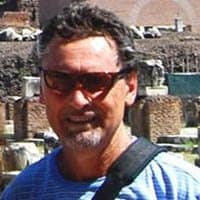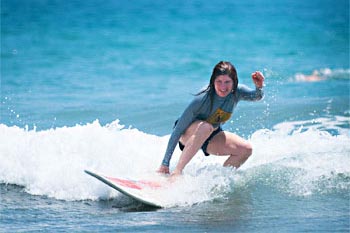
Colorful Sights of El Salvador Are Being Rediscovered
By Edward Placidi

Tourism collapsed years ago in El Salvador, but it’s now surging back.
“We are happy now” are words I heard over and over again (in Spanish, as English speakers are rare) in random conversations all over the country.
El Salvador has done seemingly the impossible–in just several years, gone from being one of the most dangerous places in Latin America to one of the safest. And the transformation has ignited tourism.
Steady Growth in ’23
“Tourism grew steadily for us in 2023, and now is taking off in 2024,” said Yesenia, a guide on the popular Ruta de las Siete Cascadas (the Seven Waterfalls Route) adventure excursion.
“Travelers are coming for our volcanoes, our waterfalls and our beaches.” And, it should be added, for the colonial towns as well.
“I missed my country and am so happy that I could finally come back to visit because it’s safe,” Silvia from Porterville, California, told me. Born in El Salvador, and now a US citizen, she had not returned for decades.
President Nayib Bukele used emergency powers and a sweeping crackdown to neutralize the gangs that terrorized and controlled the country through mass extortion. The people responded by re-electing him recently in a landslide. “He gave us back our lives,” said Nathan of Casa Verde Hostal in Santa Ana.
El Salvador’s Stunning, Colorful Sights
El Salvador has many colorful and stunning sights, and travelers are now returning to see and experience this tiny land, Central America’s smallest, where they are embraced with genuine warmth and hospitality.
One of the most popular activities, with both visitors and Salvadorans, is hiking up Llamatepec, known as Santa Ana Volcano and the tallest of the country’s 170+ volcanoes. About 3.5 hours up and down, the payoff is epic.

“Weekdays, when it’s more internationals, there may be 200 people on the volcano, but weekends, when it’s more Salvadorans, it’s as much as 500,” said Herson, a Llamatepec guide. To protect the environment, and the many hikers, no one is allowed to go up unless part of a guide-led group.
The steep path winds up under a dense forest cover; several wooden observation decks and a three-story lookout tower offer vistas of Lake Coatepeque and the two adjacent volcanoes ‒ brooding, cast-in-shadow Izalco and Cerro Verde with fumaroles of vapor swirling skyward from their cones.

An intense odor of sulfur hit us as we exited the forest into the sunlight. Numerous hawks circling overhead, cactus studding the slopes, watching our footing in the loose scree, we knew we were close. Reaching the rim and peering over the lip, the vision is so primeval and powerful that, for a moment, it didn’t seem real: The otherworldly green of the lake in the caldera far below, the swirling, intense orangey-browns of the earth and mud encircling the water, the rough-hewn, black-and-gray walls of the massive crater, the scale of the dramatic panorama.
At the top, standing at the antediluvian precipice where a false step will send you sliding to eternity, I pondered nature’s unbridled dominance – as well as marvel at how enterprising humans are: a young man hikes up every day hauling a cooler and does land-office business selling popsicles and chocolate-dipped frozen bananas on a stick.
The Ruta de Flores ‒ the popular Flower Route ‒ takes you up into cooler highlands of coffee plantations, quaint colonial villages, flowering vines, murals, markets and festivals. Among the most visited is Concepcíon de Ataco: a charming adobe settlement of uneven cobbled streets, discolored-by-time tile roofs, and brilliantly colorful murals splashed across the facades of numerous buildings.
 Ataco is famous as the mural town of El Salvador. Some are innocent and flowery with sweet themes, while others depict haunting characters and evocative moods. The sentiments and meanings are open to interpretation by the many visitors who come especially on weekends.
Ataco is famous as the mural town of El Salvador. Some are innocent and flowery with sweet themes, while others depict haunting characters and evocative moods. The sentiments and meanings are open to interpretation by the many visitors who come especially on weekends.
Catering to the influx, the village has an abundance of restaurants, coffee bars, and touristy shops and stands filled with t-shirts, ceramics, jewelry and tchotchkes.
Ruta de Flores
The queen of the Ruta de Flores, however, is picturesque, bustling Juayúa, where Saturday and Sunday are dominated by the sounds of sizzling meats and singers belting out Salvadoran favorites over high-decibel PA systems.
People come from near and far for the food festival and street party every weekend to sample everything from fried yucca and grilled rabbit to various flavors of atole, a pre-Hispanic corn-based drink typically flavored with fruit or cacao.
The carnival-like atmosphere reaches its apogee on Sunday afternoons when a table is hard to get and the main square overflows with friends, families and couples hanging out and munching on foods grabbed from the adjacent food tents. Music blasts incessantly from the PA systems, boom boxes and the open-air buses that offer rides through the town. The frying and grilling reaches a crescendo, preparing breaded shrimp, whole fish, pork chops, chorizo and more – accompanied by mixed rice and beans, salted steamed vegetables, salads and the small but extra thick Salvadoran tortillas.
Exotic and eccentric drinks set the party stage, including Piña Loca, a hollowed-out pineapple filled with a frozen pineapple and rum concoction, and Mangolaba, a mix of mango and lime juice, salt, pepper, chili powders and sauces, with beer floated on top.
 Travelers seek out waterfalls across El Salvador and one of the most exciting and challenging is the Ruta de las Siete Cascadas. The wet and wild four-hour trek was an exhilarating immersion into a watery world: we hiked up steep, forested hills where water was cascading and flowing all around us.
Travelers seek out waterfalls across El Salvador and one of the most exciting and challenging is the Ruta de las Siete Cascadas. The wet and wild four-hour trek was an exhilarating immersion into a watery world: we hiked up steep, forested hills where water was cascading and flowing all around us.
We forded streams, climbed up rock walls of pouring water, and swam in cool pools. At one point, we used ropes to pull ourselves up a steep façade of a waterfall, continued upward through the spray and mist, and walked under pounding sheets of water.
Yesenia was a little dynamo who guided us with purpose and alacrity while revealing forest secrets, from the camouflaged water tarantulas that blended into the rocks to the small fruits with milky white sap that birds love and the nests of wasps that produce a prized black honey.
The towns around the port of La Libertad is the heart of El Salvador’s beach scene with its black sand, pounding surf and warm Pacific water.
Nowhere personifies the Salvadoran seashore more than El Tunco – known as ‘Surf City.’ El Salvador is celebrated for offering among the best waves in the Americas, and El Tunco is the surfing capital.
Small but bustling and touristy, it attracts an eclectic mix of surfers, many of them Americans, the curious there to watch the  board riders in action, and those who come to eat and party.
board riders in action, and those who come to eat and party.
El Tunco is awash with large outdoor cafes lining the long waterfront, open-air restaurants with panoramic decks, bars, discos, and throbbing nightlife, as well as numerous shops and kiosks selling souvenirs and renting surfboards.
Nearby is quiet El Zonte, another renowned surfing spot but where the entire focus is on carving waves. There is no nightlife here or shops other than a few tiny grocery stores and several surfboard shops; the atmosphere is so relaxed and non-commercial, in fact, most restaurants close by 8 pm.
Like El Tunco, El Zonte has an excellent point break with big swells, but the waves here are much closer and easily accessible to the village. And the gorgeous setting, on a small palm-fringed, black-sand bay, is far more beautiful than El Tunco’s location.
Suchitoto Roots
Suchitoto is where the roots of El Salvador’s history are still in full bloom. Founded in 1528, it was the first major Spanish settlement in what is today El Salvador, used as a base to conquer the region, and remains the country’s best-preserved and most beautiful colonial town.
The Spanish era seemingly ended only yesterday here with its winding cobbled lanes, imposing stark-white cathedral, porticoes, wrought-iron balconies and windows framed by blood-red bougainvillea, and wooden doorways.
 The pride of the residents in their charming, picturesque town shines through in how well-maintained, spotlessly clean, and authentic Suchitoto is.
The pride of the residents in their charming, picturesque town shines through in how well-maintained, spotlessly clean, and authentic Suchitoto is.
The only modern intrusions are some signs and the many houses, that originally were whitewashed, painted in bright pastels (imbuing today’s Suchitoto with a joyously colorful aura).
Suchitoto once garnered wealth and prestige for its indigo (until synthetic dyes killed the industry) and there are workshops open to visitors to learn about the cultivation and dying process. Adjacent the town is Lake Suchitlán which attracts large numbers of migratory birds; a boat ride in the early morning is magical, inserting you among thousands of white pelicans, cormorants, and cranes.
Nearby is Cascada de los Tercios, a waterfall that flows in the rainy season only with the most curious rock formations formed 60,000 years ago by cooling lava: a rock face composed of hundreds of large, vertical, hexagonal pillars of basalt.
The Turquois-Browed Motmot joined me at breakfast in the garden of my hotel on my first day in El Salvador. It came with the early morning sun delighting me with its brilliant multi-colored plumage, receiving morsels of bread in exchange. It happily returned for more the next morning. Known locally as the Togoroz, El Salvador’s national bird was a metaphor for the country’s many colorful attractions that, with the dramatic recent changes, are being rediscovered.
During my 11 days there, I felt completely safe at all times everywhere I went. The general atmosphere was relaxed, happy, and genteel.
People often greeted me with “Buenos Dias” or a smile at they passed. When I asked directions, they always stopped to give detailed explanations and, in the typically kind and generous Salvadoran manner, often personally showed me the way.
 Freelance travel writer/photographer Edward Placidi has lived and traveled in 106 countries and penned articles for numerous newspapers, magazines, and websites. When not traveling he is whipping up delicious dishes inspired by his Tuscan grandmother who taught him to cook. A passionate Italophile and supporter of the Azzurri (Italian national soccer team), he lives in Los Angeles with his wife Marian.
Freelance travel writer/photographer Edward Placidi has lived and traveled in 106 countries and penned articles for numerous newspapers, magazines, and websites. When not traveling he is whipping up delicious dishes inspired by his Tuscan grandmother who taught him to cook. A passionate Italophile and supporter of the Azzurri (Italian national soccer team), he lives in Los Angeles with his wife Marian.
One of his stories was included in the Ten Best Stories on GoNOMAD in 2023!
- Camino Tales: Wine and Memories in Galicia, Spain - July 25, 2024
- Beluga Hunting in Norway - July 20, 2024
- Costa Rica: A Rainforest Chocolate Tour - July 18, 2024




